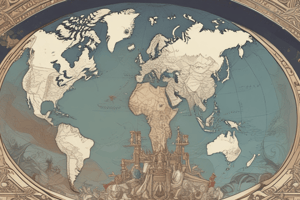Podcast
Questions and Answers
What was the primary reason for the formation of the League of Nations in 1920?
What was the primary reason for the formation of the League of Nations in 1920?
- To establish a world government
- To promote economic development in developing countries
- To maintain harmony between countries by resolving territorial disputes (correct)
- To establish a universal language
How many member states were there when the United Nations was founded in 1945?
How many member states were there when the United Nations was founded in 1945?
- 51 member states (correct)
- 100 member states
- 150 member states
- 200 member states
What is the primary source of funding for the United Nations?
What is the primary source of funding for the United Nations?
- Taxes imposed on international trade
- Voluntary contributions from its member states (correct)
- Fees from international travelers
- Grants from private foundations
What is the main goal of the United Nations' work in the area of Sustainable Development and Climate Action?
What is the main goal of the United Nations' work in the area of Sustainable Development and Climate Action?
What is the UN System comprised of?
What is the UN System comprised of?
What is the primary role of the Economic and Social Council (ECOSOC)?
What is the primary role of the Economic and Social Council (ECOSOC)?
Who appoints the Secretary-General of the United Nations?
Who appoints the Secretary-General of the United Nations?
What is the main purpose of the United Nations Trusteeship Council?
What is the main purpose of the United Nations Trusteeship Council?
How many UN Regional Groups are there?
How many UN Regional Groups are there?
What is the minimum number of votes required for major decisions on issues like who can join the UN?
What is the minimum number of votes required for major decisions on issues like who can join the UN?
Flashcards are hidden until you start studying
Study Notes
Creation of the United Nations
- The League of Nations, established in 1920, failed to prevent the 2nd World War.
- The United Nations (UN) was established on October 24, 1945, to replace the League of Nations.
- The UN was founded with 51 member states, which has now grown to 193.
Purpose and Principles
- The UN aims to bring nations together for peace, development, justice, human dignity, and well-being.
- The organization is based on the principles of justice, human dignity, and the well-being of all people.
Headquarters and Finance
- The UN Headquarters is located in New York City.
- The organization is financed by voluntary contributions from its member states.
Areas of Work
- Maintaining International Peace and Security
- Protecting Human Rights
- Delivering Humanitarian Aid
- Supporting Sustainable Development and Climate Action
- Upholding International Law
The UN System
- The UN System includes funds, programmes, specialized agencies, each with their own area of work, leadership, and budget.
- The UN itself is one part of the UN System.
- Cooperation between the UN and other entities is essential to achieve the Organization's purposes.
Principal Organs
- General Assembly: main deliberative, policymaking, and representative organ of the UN
- Security Council: maintenance of international peace and security
- Economic and Social Council (ECOSOC): coordination, policy review, policy dialogue, and recommendations on economic, social, and environmental issues
- International Court of Justice: principal judicial organ, settling legal disputes between states and giving advice
- Secretariat: carries out the day-to-day work of the UN, mandated by the General Assembly and other principal bodies
- United Nations Trusteeship Council: ensures steps are taken to prepare territories for self-government and independence
General Assembly and Voting
- Representatives of each member country meet in the General Assembly
- Each country has a single vote
- Decisions become resolutions with a majority vote
- Major decisions, such as membership, require two-thirds of the Assembly's support
UN Regional Groups
- The General Assembly is divided into five UN Regional Groups:
- African Group
- Asia-Pacific Group
- Eastern European Group
- Latin American and Caribbean States
- Western European and others Group
Studying That Suits You
Use AI to generate personalized quizzes and flashcards to suit your learning preferences.




